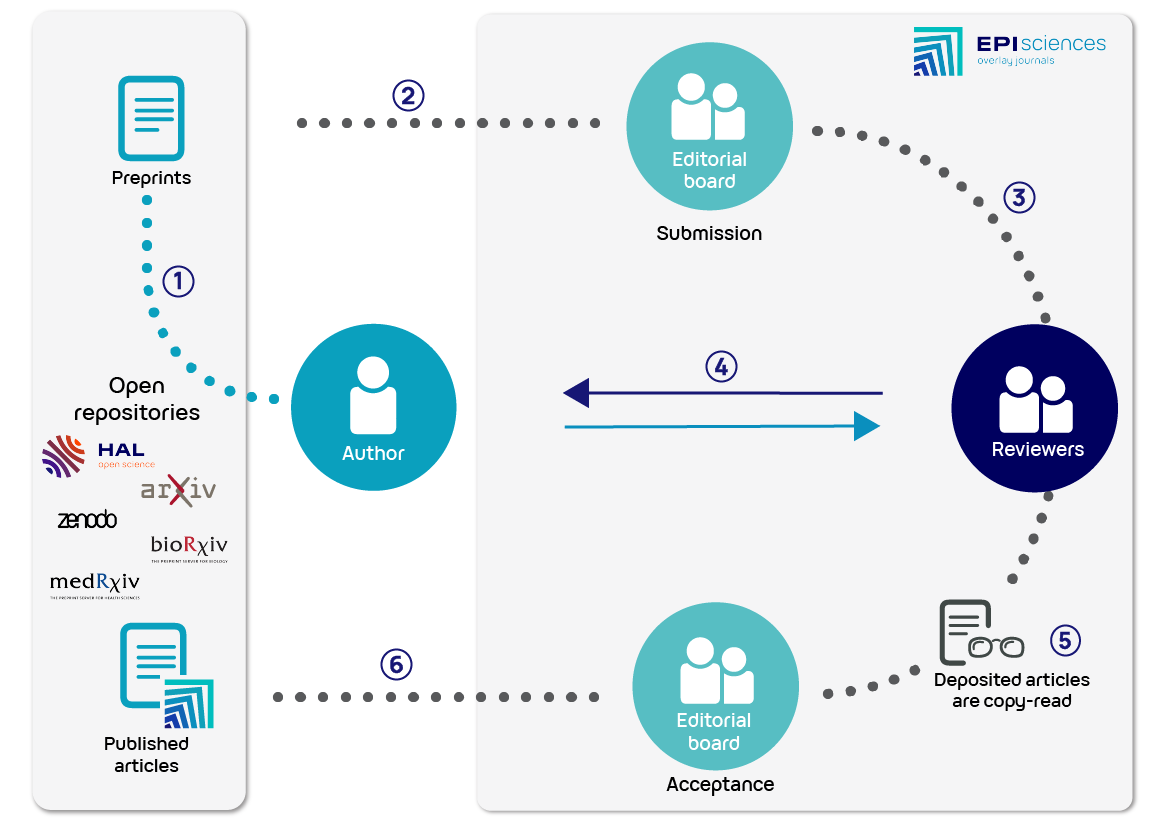Episciences is a complete platform for editing and publishing scientific overlay journals covering all disciplines.
Scientific journals and open repositories
An overlay journal is a scientific journal whose articles are held in one or more repositories. Published documents are not hosted on the journal’s website, but on an open repository or preprint server such as arXiv, HAL, Zenodo, bioRxiv, medRxiv, etc.
All Episciences journals are Diamond Open Access journals:
- There are no access fees.
- There are no publication fees.
An Episciences overlay journal has a complete publishing system on its own site which allows it to manage both the editorial workflow and the publication of articles.
This model allows for a single blind peer review: the names of the authors are known. Open peer review is also possible, depending on the choice of journals, authors and reviewers.
The publication process is backed up by the open repositories.
Workflow

- an author deposits his or her proposed article (preprint) in an open archive;
- the author then submits this preprint to an overlay journal by logging on to the overlay journal’s website;
- the editorial board of the overlay journal examines the submission and entrusts its expertise to reviewers (in single blind review or open peer review);
- the expertise received is transmitted to the author: at this stage, the article can be rejected, accepted subject to modifications, or accepted as is. The revised article, based on the evaluations, gives rise to a new version that is deposited in the open archive;
- this new version will be reviewed once more by the reviewers, in accordance with a classic review process, before being accepted or leaving for a new round of evaluation;
- once the article has been definitively validated by the journal’s editorial board, then formatted (Episciences allows the management of the copy-editing phase with external service providers), it is published on the journal’s website.
The fact of depositing an article in prepublication on an open archive allows the author to make his or her research available immediately and to protect himself or herself from possible plagiarism (the article is deposited in an institutional open archive that time-stamps the deposit, and it is indexed in scientific databases and search engines).
Evaluation and publication times are reduced by using the Episciences platform, which offers, on the same site, a complete editorial workflow and a publication interface.
Each overlay journal can choose to make the expert reports accessible, in order to make the evaluation process more transparent.
FAIR practices
Episciences meets the FAIR criteria, and the exemplary criteria defined by the Open Science Steering Committee.
Diamond open access allows immediate free access—without identification or DRM—to publications through their deposit in an open archive. Submission and publication are not conditional on the payment of a per-unit publication fee (no Article Processing Charges).
The data and metadata produced are open, standardised, structured, easily accessible and interoperable. Each published editorial unit has a unique, persistent identifier (DOI).
Throughout the editorial process, the article remains the full and complete property of its author.
Long-term preservation is ensured by Cines.
Key dates
- 2003: first draft of an overlay journal by Jean-Pierre Demailly of Institut Fourier
- January 2012: Institut Fourier contacts the CCSD again
Development starts in March - 2013: Inria joins the project. Launch of Episciences
- January 2021: Launch of the OpenAIRE Nexus project: Episciences becomes a building block of the EOSC ensemble and is integrated into the European cloud service catalogue
- March 2021: launch of the HALOWIN project (to improve interoperability with HAL)
- 2023: 10th anniversary of Episciences celebrated at the Journées Publishing another way: the epic of Episciences and overlay journals (30-31 March, Lyon)
- 2024: Launch of the nepHAL+ project (to develop an innovative autonomous submission and evaluation module) and the Édisciences project (to editorialise the content published on Episciences)